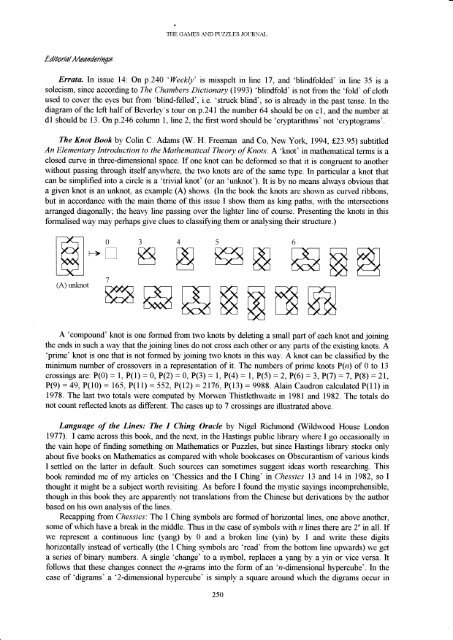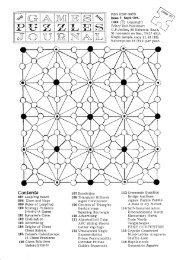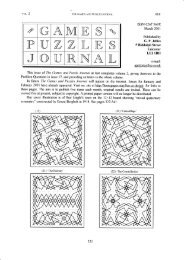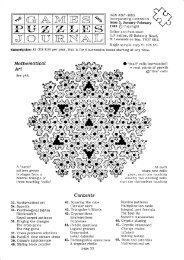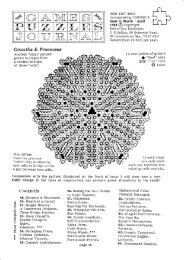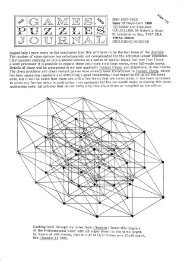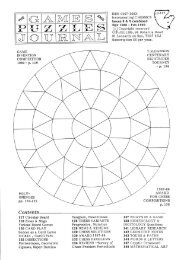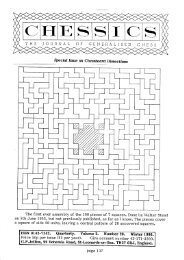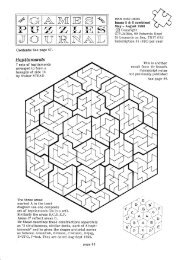The Games and Puzzles Journal, #15 - Mayhematics
The Games and Puzzles Journal, #15 - Mayhematics
The Games and Puzzles Journal, #15 - Mayhematics
You also want an ePaper? Increase the reach of your titles
YUMPU automatically turns print PDFs into web optimized ePapers that Google loves.
TIIE GAMES AND PIjZZLES JOLiRNAL<br />
Edttunal tffie<strong>and</strong>annge<br />
Errata.In issue 14: On p.240'Weekly' is misspelt in line 17, <strong>and</strong>'blindfolded' in line 35 is a<br />
solecism, since according to <strong>The</strong> Chambers Dictionary (1993) 'blindfold' is not *om the 'fold' of cloth<br />
used to cover the eyes but from 'blind-felled', i.e. 'struck blind', so is already in the past tense. ln the<br />
diagram of the left half of Beverley's tour on p.241 the number 64 should be on cl, <strong>and</strong> the number at<br />
dl should be 13. Onp.246 column l, line 2, the first word should be 'cryptarithms' not 'cryptograms'.<br />
<strong>The</strong> Knot Book by Colin C. Adams (W. H. Freeman <strong>and</strong> Co" New York, 1994, f23.95) subtitled<br />
An Elementary Introduction to the Mathemstical <strong>The</strong>ory of Knots. A 'knot' in mathematical terms is a<br />
closed curve in threedimensional space. If one knot can be deformed so that it is congruent to another<br />
without passlng through itself anlwhere, the two knots are of the same tJpe. In particular a knot that<br />
can be simplified into a circle is a 'trivial knot' (or an 'unknot'). It is by no means always obvious that<br />
a given knot is an unknot, as example (A) shows. (In the book the knots are shown as curved ribbons,<br />
but in accordance with the main theme of this issue I show them as king paths, with the intersections<br />
arranged diagonally; the heavy line passing over the lighter line of course. Presenting the knots in this<br />
formalised way may perhaps give clues to classifying them or analysing their structure.)<br />
0<br />
T<br />
ua<br />
J<br />
H HH HffiH<br />
(A)UNKNOI<br />
ffiHHffiHffiffi<br />
A 'compound' knot is one formed from two knots by deleting a small part of each knot <strong>and</strong> joining<br />
the ends in such a way that the joining lines do not cross each other or any parts of the existing knots. A<br />
'prime' knot is one that is not formed by joining two knots in this way. A knot can be classified by the<br />
minimum number of crossovers in a represeirtation of it. <strong>The</strong> numbers of prime knots P(n) of 0 to 13<br />
crossings are: P(0) = 1, P(l):0, P(2):0, P(3) = 1, P(4) = 1, P(5) :2,P(6) = 3, P(7) =7,P{8}=21,<br />
P(9) : 49, P(10) = 165, P(l l) = 552, P(12) : 2176, P(13) = 9988. Alain Caudron calculated P(l1) in<br />
1978. <strong>The</strong> last two totals were computed by Morwen Thistlethwaite in l98l <strong>and</strong> 1982. <strong>The</strong> totals do<br />
not count reflected knots as differeirt. <strong>The</strong> cases up to 7 crossings are illustrated above.<br />
Language of the Lines: <strong>The</strong> I Ching Oracle by Nigel Richmond (Wildwood House London<br />
1977). I came across this book, <strong>and</strong> the next, in the Hastings public library where I go occasionally in<br />
the vain hope of finding something on Mathematics or <strong>Puzzles</strong>, but since Hastings library stocks only<br />
about five books on Mathematics as compared with whole bookcases on Obscurantism of various kinds<br />
I settled on the latter in default. Such sources can sometimes $rggest ideas worth researching. This<br />
book reminded me of my articles on 'Chessics <strong>and</strong> the I Ching' rn Chessics 13 aad 14 in 1982, so I<br />
thought it might be a subject worth revisiting. As before I found the mystic sayings incomprehensible,<br />
though in this book they are apparently not translations from the Chinese but derivations by the author<br />
based on his own analysis of the lines.<br />
Recapping fram Chessics: <strong>The</strong> I Ching syrnbols are formed of horizontal lines, one above another,<br />
some of which have a break in the middle. Thus in the case of s5,mbols with r lines there are 2" n all.lf<br />
we represent a continuous line (yang) by 0 <strong>and</strong> a broken liae (yin) by I <strong>and</strong> write these digits<br />
horizontally instead of vertically (the I Ching symbols are 'read' from the bottom line upwards) we get<br />
a series of binary numbers. A single 'change' to a symbol, replaces a yang by a yrrr or vice versa. It<br />
follows that these changes connect the r-grams into the form of an 'redimensional hypercube'. ln the<br />
case of 'digrams' a '2dimensional hypercube' is simply a square around which the digrams occur in<br />
250


